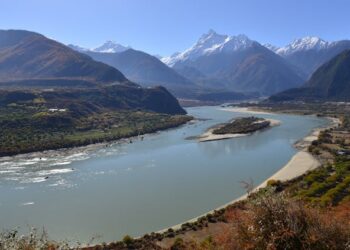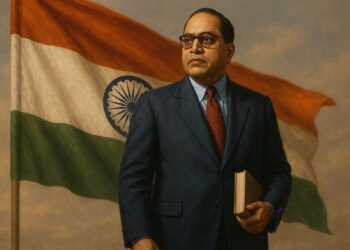By Swati Singh Parmar
A bottomless social stratification of inequality exists in the form of caste in Indian society. Caste transposes economic, cultural, political, and educational marginalisation. The egregious forms of discrimination that the individuals belonging to the ‘scheduled castes’ (i.e. those who lie at the lowest point in this stratification) face, range from servitude, bondage, manual scavenging, occupational fatalities, selective policing, unaccounted rapes, and murders, among others. Indian diaspora has catapulted the escape of casteism from its domestic limits. Widely ignored on the national plane (except for the vote bank politics dominated by caste-based politics), emigrants have transported caste to the international plane. As a result, millions of individuals in South Asia and beyond remain affected by caste discrimination.
This blogpost outlines the entrenched caste identity among Indians and its migration to international society. It problematises India’s reluctance to address caste as an international legal concern and calls for Indian co-operation and acceptance of international law encompassing caste within its fold. It does so by drawing an analogy of race with caste.
The Hold of Caste
Caste originated as an occupation-specific gradation on the purity scale on the basis of which Indian Hindu society has been socio-culturally sculpted. Having its roots in ancient Indian mythology (like Vedas and Smritis) as an occupational and then hereditary categorisation of the society, caste has been perpetuated and now is retained as a hereditary social rank. The caste system divides the Hindu society into four rigid compartments: Brahmins (Priests and teachers), Kshatriyas (Warriors and rulers), Vaishyas (Traders and merchants) and Shudras (Labourers). Dalits (Sweepers and Toilet cleaners) were not categorised as they were regarded as ‘outcastes’. Caste has nowadays escaped its religion-specificity and traversed beyond the strict framework of Hinduism. Its retention secures a strong religious and social sanction that protects the hegemony of the upper castes. It is a significant descriptor of disparity and a deceptive social construct that retains the “oldest system of human oppression, subjugation and degradation”.
Caste functions on the rationale of graded purity situated in hierarchical divisions. As a “quintessential social and individual identifier”, caste is an important driver of poverty, inequality and exclusion in India. Caste discrimination legitimises apartheid in matters of residential segregation (thus creating a socio-spatial stigma), job discrimination, employment, incarceration, police brutality, access to sanitation, discriminatory wages, and others. Even in matters of choice of a particular stream of study, caste is an important signifier. Insidious casteism is faced even by National Law Universities’ students and by judges in the courts of ‘justice’ too.
Indian society has sustained and nurtured the caste identities because of their dividends for the dominant voices as the “rights and privileges of higher castes become the disabilities of the lower caste” (Thorat).
A Relegated Concern of Caste-Discrimination
In response to the denouncement of the scheduled castes (i.e. those who lie at the lowest point in this stratification), India affords and reserves certain benefits to these castes through Articles 15(4) and 16(4) of the constitution (hereinafter reservations). The effect of these theoretically protective provisions in the Constitution on mainstreaming the socio-economic status of the scheduled caste has been abysmal. The social contempt against reservations hollows its Indian Constitutional promise. The privileged ‘forward’ castes accuse this reservation policy of the Constitution as anti-forward caste that adversely affects their socio-economic rights. An empirical study refuting this prejudice demonstrates that at the systemic level, reservation has not adversely affected the participation of ‘forward’ castes in percentage terms. This contempt against reservations is often wrongly rationalized as an instrument of inefficiency in public administration.
Barbaric forms of caste discrimination have been normalised in India, from denial of water during a drought, being beaten to death in public view for marrying an ‘upper’ caste Muslim woman, to other violent atrocities against Dalits. Even a modest assertion by Dalit males, including sporting a moustache, riding a horse, objecting to the removal of Ambedkar’s poster, eating in front of ‘upper’ caste men, and touching their food plates exasperates the ‘upper’ castes in India. The plight of Dalit women is even worse. Unfortunately, the concerns of the marginalized are not the political mainstream concerns with electoral ramifications.
Existing laws in India do the bare minimum to address caste discrimination. Legal protection from discrimination is mainly theoretical, while caste discrimination remains blatant and even more so in implementing anti-caste laws. Popular decisions of the Supreme Court of India, which are praised by ‘forward’ castes, such as M. Nagaraj and Others v UOI (which rendered the reservation for promotions in public employment a practical impossibility) and Jarnail Singh v. Lachhmi Narayan Gupta (which introduced a creamy layer among scheduled castes) are unfortunate illustrations of the Court’s oblivion to the rationale behind reservations, which remains discriminatory. Shockingly, the Supreme Court has even diluted the provisions of the Scheduled Castes and Scheduled Tribes (Prevention of Atrocities) Act in cases like Khuman Singh v. State of Madhya Pradesh. The Supreme Court in the case of Dr Subhash Kashinath Mahajan v. The State of Maharashtra has even criticized the ‘abuse of law of arrest in cases under the Atrocities Act’. In fact, most legal provisions for the protection of marginalised sections are alleged of being misused and abused by the marginalised. Even a former Supreme Court judge accuses rape laws of being misused, while the data on conviction rates exposes the amateurishness of this claim.
Scheduled castes experience a similar social inclusion (via the Constitution) and ideological exclusion in India and outside that Muslims experience in post-Cold War popular and political imagery in Europe and America. Both experience a similar systemic marginalization in social negotiations, political spaces, and economic bargain, and there even exists an intersectionality between the two. The capability of legal protection in addressing casteism is a comfortable assumption rooted in a bigger assumption of law being a panacea and turns a blind eye to the reality and enormity of it.
The Migration of Caste and International Law
Migration has effused caste’s organic weight and diluted its religion-specificity. Primarily associated with South Asia, casteism has traversed to Australia, the United Kingdom (UK) and the United States. Ethnographic empirical work has shown such a re-institutionalization of caste following the Indians’ migration to UK that scholars have called for the adoption of relevant domestic legislation in the UK so that such caste-specific concerns can be addressed. Despite having turned into a global phenomenon, caste has not been able to reflect on the research radar of international law scholars. The Third World Approach to International Law (hereinafter TWAIL) scholars who employ a critical, anti-hegemonic, anti-hierarchal framework for international law, have not attempted to address caste discrimination either.
India has relegated caste discrimination in the national discourse and refuses that the issue falls within the scope of the Convention on the Elimination of all Forms of Racial Discrimination (hereinafter CERD). The CERD Committee has enquired into caste-based discrimination (under discrimination on the basis of ‘descent’) and shared its concerns regarding the domestic implementation of CERD for the protection of human rights of the marginalized castes in its concluding observations for India, Nepal, Pakistan, Bangladesh and the UK. Although most States concur with the interpretations of the treaty bodies, India is an exception. Precisely, India opposes CERD’s interpretation and argues that caste cannot be seen as falling under the term ‘descent’ of CERD Article 1(1). India’s stance reveals its insecurity regarding an international scrutiny as was the case on some previous occasions. This distrustful refusal seems to be the result of two primary unconvincing claims. First, the erstwhile Solicitor General of India asserted that ‘caste is not of racial origin and is unique to Indian society’, overlooking the General recommendation XXIX on CERD’s Article 1 adopted in its 61st session. He added that ‘caste has been addressed in the Indian Constitution’, reiterating the panacea assumption. This refusal also echoes the national ego of laws that evades any possible redressal through the compliance with an international legal framework. Second, in support of the said refusal, Dipankar Gupta, an Indian sociologist, shared simplistic reasons of lineage and genealogy to not equate caste with race. This detached claim degenerates the interpretative potential of Article 1 of CERD by limiting it to a biological analogy, ignoring the parallel social realities.
Caste as an accident of birth qualifies as a discriminatory form under CERD. Though different phenomenologically, caste resembles race functionally. The theoretical underpinnings of caste discrimination draw its cognate relationship with racism. The difference in etymology and functionality of the two does not rule out the similarity and sometimes, even congruence, of operation of both. There is no apparent harm for India to let ‘caste’ be interpreted within ‘descent’, letting CERD Committee’s interpretation prevail over a statist politically skewed (mis)interpretation. Nonetheless, these theoretical arguments have slim chances to become the actual solutions, even more so because they have not been flagged enough by the scholars. Ambedkar, a socio-political scholar and Dalit activist, had warned the Indian Government to take the plight of the depressed castes to the League of Nations. He had drawn glaring similarities between caste discrimination and the discrimination faced by the African Americans. But his works themselves are relegated and under-read in the caste dominated academia. In addition, the critical pulse of TWAIL scholarship has not reflected on caste marginalisation. On States’ radar, less prioritized human rights treaties such as Convention Against Torture, and Convention on Enforced Disappearances have shriveled in comparison with the high prioritized trade and foreign investment treaties. The myopic economic dividends of such treaties for a few weigh higher than the human rights of all in a neo imperial State.
Concluding Remarks
Recognition of race as a praxis of discrimination and the non-recognition of caste as a similar discriminatory practice is a blatant denial of a genuine equivalence. Discrimination on the basis of race prevents the recognition of people as subjects of international law and the respect of their rights, and there seems to be no reason why caste should not be seen in the same way. India’s refusal to acknowledge discrimination on the basis of caste as incompatible with human rights law reflects the myopic statist view of international law which limits international law to a consent-based system. CERD Committee’s legally coherent interpretation should not be subdued by a political and incoherent interpretation of ‘descent’ due to the insecurities and ego of Statist claims.
Swati Singh Parmar is an Assistant Professor in International Law at the Dharmashastra National Law University, Jabalpur, India.
Republished under a Creative Commons Licence from Völkerrechtsblog, 15.06.2023, doi: 10.17176/20230615-110944-0.











